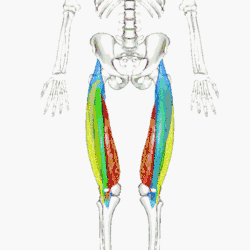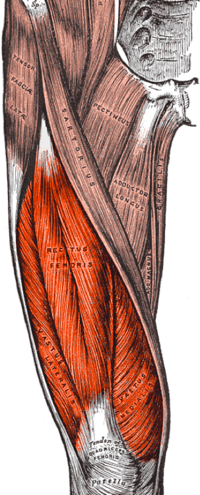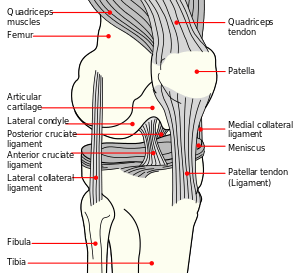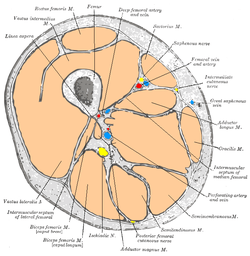Quadriceps femoris muscle
The quadriceps femoris (/ˈkwɒdrɪsɛps ˈfɛmərɪs/, also called the quadriceps extensor, quadriceps or quads) is a large muscle group that includes the four prevailing muscles on the front of the thigh.
| Quadriceps femoris muscle | |
|---|---|
 Quadriceps femoris, with different muscles in different colors. rectus femoris - blue vastus lateralis - yellow vastus intermedius - green vastus medialis - red | |
| Details | |
| Origin | Combined rectus femoris and vastus muscles |
| Insertion | Tibial tuberosity |
| Artery | Femoral artery |
| Nerve | Femoral nerve |
| Actions | Knee extension; Hip flexion (Rectus femoris only) |
| Identifiers | |
| Latin | Musculus quadriceps femoris |
| MeSH | D052097 |
| TA | A04.7.02.017 |
| FMA | 22428 |
| Anatomical terms of muscle | |
It is the great extensor muscle of the knee, forming a large fleshy mass which covers the front and sides of the femur. The name derives from Latin four-headed muscle of the femur.
Structure

It is subdivided into four separate muscles (the 'heads'):
- Rectus femoris occupies the middle of the thigh, covering most of the other three quadriceps muscles. It originates on the ilium. It is named from its straight course.
- The other three lie deep to rectus femoris and originate from the body of the femur, which they cover from the trochanters to the condyles:
- Vastus lateralis is on the lateral side of the femur (i.e. on the outer side of the thigh).
- Vastus medialis is on the medial side of the femur (i.e. on the inner part thigh).
- Vastus intermedius lies between vastus lateralis and vastus medialis on the front of the femur (i.e. on the top or front of the thigh), but deep to the rectus femoris. Typically, it cannot be seen without dissection of the rectus femoris.
All four parts of the quadriceps muscle ultimately insert into the tuberosity of the tibia via the patella, where the quadriceps tendon becomes the patellar ligament.
There is a small fifth muscle of the quadriceps complex called the articularis genus that is not often included.
In addition, cadaver studies have confirmed the presence of a sixth muscle, the tensor vastus intermedius.[1] While the muscle has variable presentations, it consistently originates at the proximal femur, runs between the vastus lateralis and vastus intermedius muscles, and inserts distally at the medial aspect of the patellar base.[1] Historically considered a part of the vastus lateralis, the tensor vastus intermedius muscle is innervated by an independent branch of the femoral nerve and its tendinous belly can be separated from the vasti lateralis and intermedius muscles in most cases.[1]
Nerve supply
Femoral nerve (L2, L3, L4).
Function
All four quadriceps are powerful extensors of the knee joint. They are crucial in walking, running, jumping and squatting. Because the rectus femoris attaches to the ilium, it is also a flexor of the hip. This action is also crucial to walking or running as it swings the leg forward into the ensuing step. The quadriceps, specifically the vastus medialis, play the important role of stabilizing the patella and the knee joint during gait.[2]
Society and culture
Training
In strength training, the quadriceps are trained by several leg exercises. Effective exercises include the squat and leg press. The isolation movement (i.e. targeting solely the quadriceps) is the leg extension exercise.
In body building communities, this muscle is colloquially referred to as the "leg triceps".[3]
Etymology
The proper Latin plural form of the adjective quadriceps would be quadricipites. In modern English usage, quadriceps is used in both singular and plural. The singular form quadricep, produced by back-formation, is frequently used.
Additional images
 The quadriceps tendon connects to the top part of the kneecap (patella)
The quadriceps tendon connects to the top part of the kneecap (patella) Cross-section through the middle of the thigh.
Cross-section through the middle of the thigh. The quadriceps forms the bulk of front part of the thigh.
The quadriceps forms the bulk of front part of the thigh.
See also
References
- Grob, K; Ackland, T; Kuster, MS; Manestar, M; Filgueira, L (6 January 2016). "A newly discovered muscle: The tensor of the vastus intermedius" (PDF). Clinical Anatomy. 29 (2): 256–263. doi:10.1002/ca.22680. PMID 26732825.
- Therapeutic Exercises, Carolyn Kisner & Lynn A. Colby, 5th ed. (2002) 692-93.
- Monaghan, L. (2002). Vocabularies of motive for illicit steroid use among bodybuilders. Social Science & Medicine, 55(5), 695-708.
External links
| Wikimedia Commons has media related to Quadriceps femoris muscle. |
- Quadriceps_muscle at the Duke University Health System's Orthopedics program
- Muscles/Quadriceps at exrx.net
- "Anatomy diagram: 39960.000-1". Roche Lexicon - illustrated navigator. Elsevier. Archived from the original on 2014-01-01.